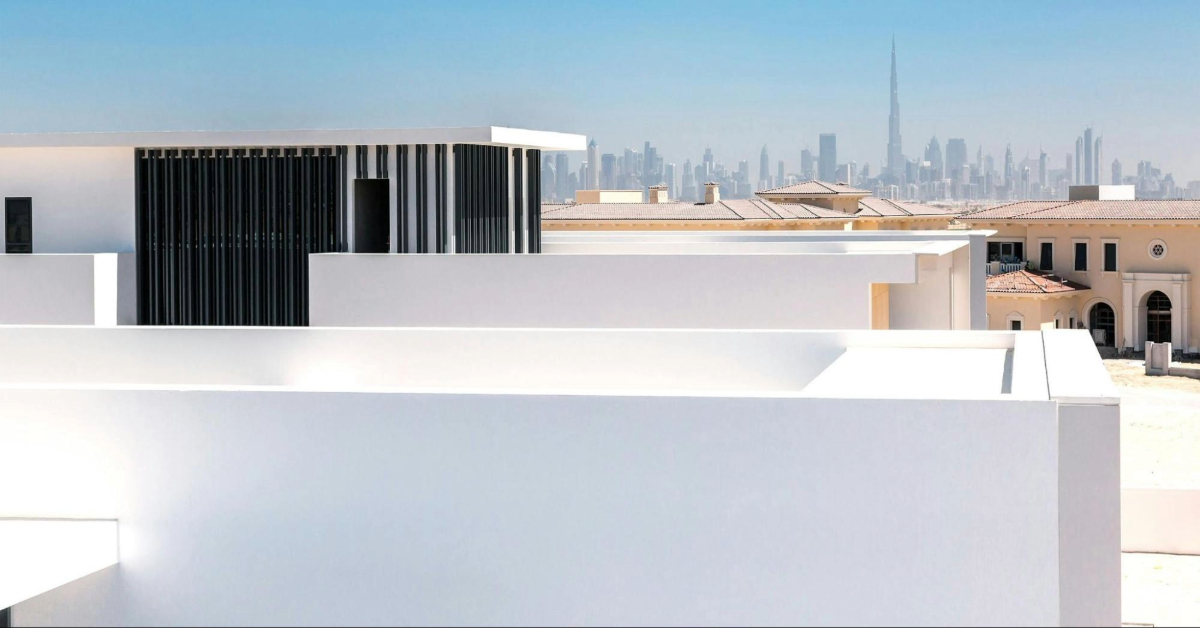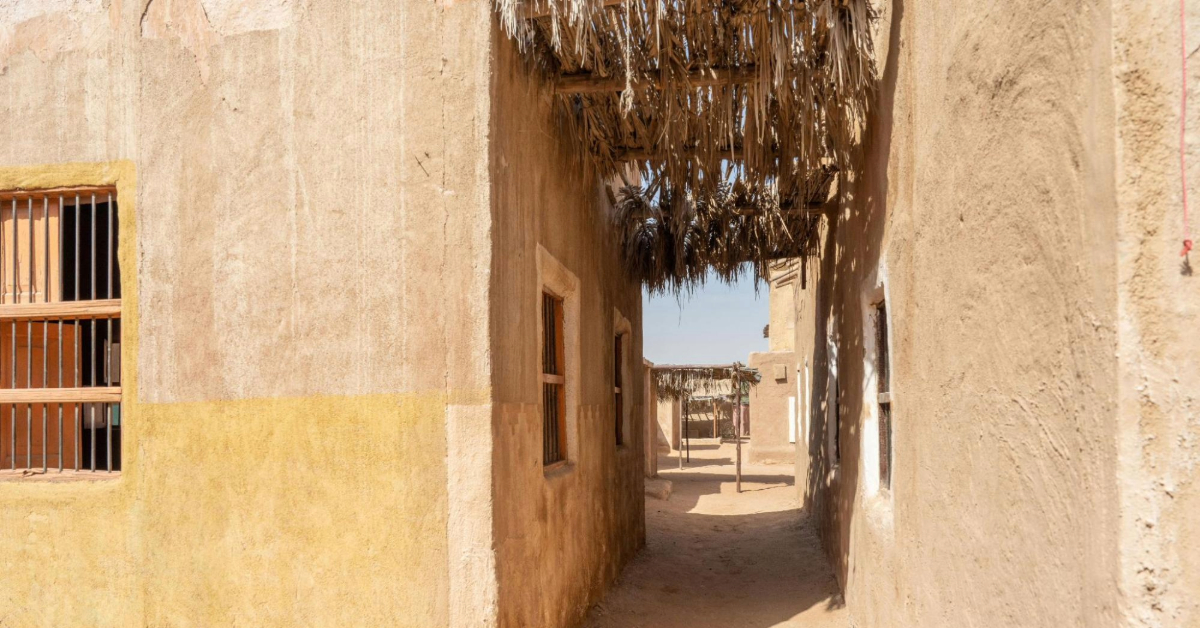Traditional desert homes in the UAE were built with clever cooling in mind. Courtyards, coral stone walls, and calm, shaded lanes helped families stay fresh in the fierce desert heat. Long before fans or fancy air conditioning, these smart structures used breeze towers to beat the burn.
Today, these cooling concepts continue in modern desert homes across the UAE. From smart design to sustainable details, many homes on Property Finder still reflect this cooling charm. It’s a perfect blend of culture and clever construction made for the Gulf’s sunny setting.

- Traditional heat management systems in traditional neighbourhoods
- The benefits of courtyards in traditional desert homes
- The importance of having a wind tower or Barjeel
- Wind tower houses in the UAE today
- Materials that kept the interiors of traditional desert homes cool
- Qasr Al Hosn and its significance
- The importance of oases in shaping the cool microclimates for homes
- The importance of falaj
- The practicality of the Aris houses
- Heat reduction in clusters and streets
- The difference between desert homes and desert mountain homes in the UAE
- Room layouts that supported passive cooling inside homes
- Importance of privacy screens
- The inspiration from desert homes for modern-day builders
- Architecture ideas applied to modern-day cities
- Masdar City: A case study for modern-day construction
- Learnings for renovators and property seekers
- Quick terminologies to know
- Key takeaways
- FAQs
Traditional heat management systems in traditional neighbourhoods
Historic hubs like Al Fahidi took both climate and comfort into careful consideration. Homes were built to block the blazing sun while still protecting people’s privacy.
Shaded streets and central courtyards helped cut down the heat while keeping things cool and calm indoors. Breezy builds brought in the cool creek current while blocking the burning afternoon beams, making daily life both peaceful and practical.
The benefits of courtyards in traditional desert homes
Courtyards were a clever core feature in traditional desert homes across the Gulf. These cool, courtyard-style spaces let warm air waft upward and out, creating calm, continuous circulation.
Simple structures and soft colours stopped heat from sneaking in. This smart setup effectively maintained temperatures, protected privacy, and respected the region’s cultural customs, all while creating a comfortable space for gathering and growth.
The importance of having a wind tower or Barjeel
Wind towers were clever cooling tools used in traditional homes. These tall, rooftop towers caught the breeze and pushed it down into the rooms while pulling warm air up and out.
In the historic districts of Dubai, homes with wind towers and courtyards became a common and clever construction choice, keeping spaces cool long before air conditioning became available.
Wind tower houses in the UAE today
If you’d like to see wind-tower homes up close, head to Al Fahidi by the Dubai Creek. Thanks to careful conservation, many of these traditional towers have been preserved and protected.
These historic houses now serve cultural purposes, showing how innovative structures kept homes calm, cool, and comfortable, even in the desert heat.
Materials that kept the interiors of traditional desert homes cool

To keep things cool inside, traditional homes were built with coral and sea stone. These natural materials were paired with lime mortar, palm wood, teak, and gypsum to form strong, sturdy walls.
Coral helped block the heat, while lime mortar added strength and stability. You can still spot this clever construction in many of Dubai’s historic districts and museums today.
Qasr Al Hosn and its significance
Qasr Al Hosn is one of Abu Dhabi’s oldest and most cherished cultural landmarks. It shows how coral stone and mangrove beams were combined to craft a cool, classic structure with timeless touches.
As one of the city’s earliest concrete buildings, it stands as a clear example of climate-conscious construction, designed with care to handle the Gulf’s heat while showcasing stunning traditional detail.
The importance of oases in shaping the cool microclimates for homes
Now a proud UNESCO World Heritage Site, Al Ain Oasis stays shaded by over 147,000 date palms and cooled by the clever falaj irrigation channels.
This smart system shaped a cooler, calmer climate, perfect for supporting soft adobe homes and sustainable farming in the heart of the desert.
The importance of falaj
A falaj is a gravity-fed water channel that plays a crucial role in delivering water to farms and family homes.
Often flowing beneath palm-filled paths, it adds humidity, creates cooling shade, and softens the heat around homes and walkways in oases like Al Ain.
The practicality of the Aris houses
Arish homes were constructed using palm trunks and plaited fronds, resulting in light and breathable walls and roofs. This smart setup lets air slip through, keeping the space shaded.
Perfect for coastal corners and oasis settlements, these practical palm-built places were a popular pick during the scorching summer seasons.
Heat reduction in clusters and streets
To create shade, traditional towns were built with short streets and slim, shaded alleys. Homes stood close together, cutting down direct sunlight and keeping paths pleasantly cool.
This smart street setup softened the heat and made spaces between homes more comfortable, principles that still shape today’s climate-conscious communities.
The difference between desert homes and desert mountain homes in the UAE

In the desert lowlands and along the coastal belt, builders selected clever, climate-friendly materials such as coral, gypsum, and palm wood. Courtyards and clever cooling wind towers kept homes breezy and beautifully balanced.
Meanwhile, in the mountainous areas like Shimal in Ras Al Khaimah, they shifted their style, using sturdy wadi stone and smaller spaces to suit the steep slopes.
These clever, compact cliffside homes connected seamlessly with the steep, stony slopes, standing in contrast to the coastal, wind-tower houses built for open, airy spaces.
Room layouts that supported passive cooling inside homes
To keep indoor spaces cool, homes were built around central courtyards that provided shade during the day and cooler air at night. Partially open loggias and screened sections helped control heat and shield against sand.
During the summer, people slept on roof terraces, taking advantage of daily temperature drops and making the most of natural cooling without the use of machines.
Importance of privacy screens
Carved plaster and timber screens helped soften sunlight and support steady airflow indoors. Lime-based layers bounced off the bright sun and protected the porous walls—keeping homes strong and safe in the salty seaside air.
The inspiration from desert homes for modern-day builders
The most important ideas included placing openings to draw in breezes, adding courtyards for improved airflow, utilising thick walls and deep shade to mitigate heat, and planning streets to support a cooler microclimate. These smart steps helped keep homes comfortable, long before cooling technology existed.
Architecture ideas applied to modern-day cities
In Abu Dhabi’s Masdar City, passive planning takes priority. Shaded streets and a striking wind tower were in place even before solar panels arrived. Special construction materials support significant savings in both power and water, unlike many similar-sized sites across the UAE.
At the mouth of the Creek, Al Shindagha Museum stands as a shining showcase of heritage. Its pavilions preserve the past through stories of daily duties, desert dwellings, and trading traditions, perfectly linking classic craftsmanship with the city’s cultural roots.
Masdar City: A case study for modern-day construction
Masdar City follows the smart, shaded style of historic Arab towns, with narrow streets and a central wind tower.
IRENA’s HQ proves passive design works, cutting energy use by 64% through clever cooling and clean tech.
At Masdar Tech Park, start-ups thrive in sustainable spaces made from recycled containers.
Slim streets and shaded structures help keep the city cooler, utilising smart street angles to capture gentle breezes and shield against strong sunlight.
Learnings for renovators and property seekers
For comfort with lower cooling costs, opt for homes with cross-ventilation, courtyards, and strategic orientation.
If you’re exploring modern communities, look for shaded paths and atriums that echo heritage styles. These will help you stay cool and comfortable throughout the year.
Quick terminologies to know
- Barjeel (Wind Tower): A brilliant breeze-catcher, the Barjeel is a rooftop shaft that pulls in high-level airflow while pushing warm air out. These were common in old Dubai homes, with preserved examples still standing proudly in Al Fahidi.
- Arish: Made from palm trunks and plaited fronds, Arish homes were perfect for the hot season, light, breathable, and easy to build. Today, museum exhibits and Dubai Culture programmes showcase how this style influenced the transition to modern homes.
- Falaj: A flowing, gravity-fed channel that cooled oases and watered the land. Found beneath palm groves in places like Al Ain, the falaj played a crucial role in creating calm, cool microclimates.
Key takeaways
Traditional Emirati desert homes were carefully crafted to cope with the Gulf’s dry and demanding climate. With courtyards, cooling wind towers, and clever use of local materials, these homes offered comfort without extra energy.
In desert mountain areas, builders used sturdy stone walls and small spaces to keep the heat out. These smart, sustainable choices continue to inspire today’s eco-friendly designs across the UAE.
Frequently Asked Questions (FAQs)
Traditional UAE homes remained cool without air conditioning by utilising clever construction and climate-aware design features. Barjeel breezes, shaded spaces, and thick thermal walls worked wonders, blocking heat and boosting airflow. These passive picks kept desert dwellings cool, proving that smart structure beats scorching sun.
Stone-strong mountain homes in spots like Shimal use small spaces and sturdy walls to capture cool and shut out the sun.
By the coast, coral, palm, and barjeel welcome the creek breezes with ease. Each design fits its setting, solid for slopes, breezy for beaches.
You can find desert dwellings in Al Fahidi’s breezy barjeel homes, Qasr Al Hosn’s sea-stone structures, and Al Ain’s falaj-fed farms.
For modern picks with desert-style charm, scroll through Data Guru, compare cooled communities, and chat with a SuperAgent to set up a smart, sustainable viewing.